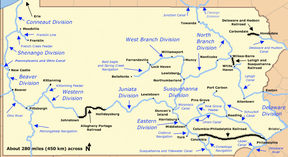Leiper Canal facts for kids
Quick facts for kids Leiper Canal |
|
|---|---|

Map of historic Pennsylvania canals and connecting railroads
|
|
| Specifications | |
| Locks | 3 |
| Status | Historic, abandoned |
| History | |
| Original owner | George Leiper |
| Date completed | 1829 |
| Date closed | 1852 |
| Geography | |
| Start point | Leiper stone quarry near Springfield |
| End point | Delaware River at Eddystone |
| Connects to | Delaware River |
The Leiper Canal was a short but important waterway built in Pennsylvania during the 1820s. It was about 3 miles (4.8 km) long and followed Crum Creek in Delaware County. The canal helped transport stone from its owner's quarry to the Delaware River. It operated from 1829 until 1852.
Contents
Building the Leiper Canal
Before the canal, a special railway called the Leiper Railroad moved stone from the quarry. This railway was pulled by horses and had been in use for 18 years.
The idea for a canal actually came from Thomas Leiper, the father of the canal's owner, George Leiper. Thomas first asked to build a canal way back in 1791, but the government said no. However, by 1824, things had changed. People were more open to new transportation ideas.
A Time of Canals
The early 1800s was a busy time for building canals in the United States. This period is often called the "American Canal Age." Canals like the Lehigh Canal and Schuylkill Canal were very successful. Other big projects, like the Erie Canal in New York, were also being built.
Because of this excitement, the Pennsylvania government quickly approved Thomas Leiper's second request for a canal. His son, George Leiper, then took on the job of building it.
The Leiper Canal was one of several canals in Pennsylvania built with private money. Others included the Union Canal and the Schuylkill Canal. These private canals operated at the same time as the larger Pennsylvania Canal System.
The Leiper Canal was finished in 1828. It was designed to carry heavy loads of stone in flat-bottomed boats. The stone came from George Leiper's quarry near Springfield Township and was taken to the Delaware River at Eddystone. The canal replaced the horse-powered Leiper Railroad and was used from 1829 to 1852.
How the Canal Worked and Its End
The Leiper Canal had three locks. Locks are special sections of a canal that help boats move up or down between different water levels.
In 1852, the Leiper family decided to reopen their old railway. The canal and its locks were eventually filled in. This shows how new railway technology became better and replaced canals.
Leiper's Legacy
The Thomas Leiper Estate, which includes the family's historic home, was added to the National Register of Historic Places in 1970. The Thomas Leiper House is now a public museum in Wallingford.

